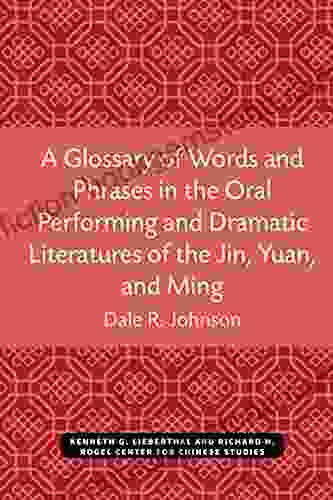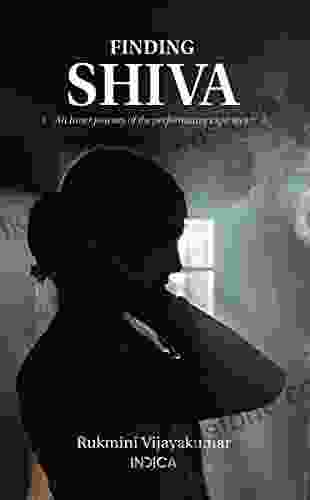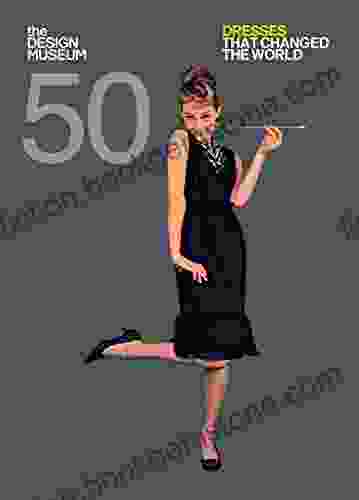Glossary of Words and Phrases in the Oral Performing and Dramatic Literatures

4.5 out of 5
| Language | : | English |
| File size | : | 69893 KB |
| Text-to-Speech | : | Enabled |
| Screen Reader | : | Supported |
| Enhanced typesetting | : | Enabled |
| Print length | : | 695 pages |
This glossary provides definitions for a variety of words and phrases used in the oral performing and dramatic literatures. These terms are commonly encountered in discussions of theater, dance, and other forms of live performance.
- Acting: The art of creating a character and bringing it to life on stage or in front of a camera. Acting involves using a variety of vocal and physical techniques to convey the character's emotions, motivations, and actions.
- Blocking: The arrangement of actors on stage and their movements during a performance. Blocking is used to create a visual composition that supports the story and characters.
- Characterization: The development of a character's personality, motivations, and relationships. Characterization is achieved through a variety of means, including dialogue, action, and physical appearance.
- Choreography: The art of creating and arranging dance movements. Choreography is used to tell a story, express emotions, or create a pleasing visual spectacle.
- Costume: The clothing and accessories that actors wear during a performance. Costume is used to create a character's visual identity and to convey information about their social status, occupation, and personality.
- Dance: A form of performance art that involves the use of movement to express emotions and ideas. Dance can be performed solo, in pairs, or in groups.
- Dialogue: The spoken words of the characters in a play or other dramatic work. Dialogue is used to advance the plot, develop the characters, and convey the playwright's themes.
- Dramatic literature: A genre of literature that is intended to be performed. Dramatic literature includes plays, screenplays, and operas.
- Gesture: A movement of the body or limbs used to express a character's emotions or intentions. Gestures can be used to emphasize words, create a mood, or convey information.
- Improvisation: The art of creating spontaneous and unrehearsed performances. Improvisation is often used in theater and dance to explore new ideas and to develop characters and stories.
- Lighting: The use of light to create a mood, atmosphere, or specific effect on stage. Lighting can be used to highlight characters, focus the audience's attention, and create a sense of time and place.
- Makeup: The use of cosmetics to alter an actor's appearance. Makeup is used to create a character's physical identity and to convey information about their age, race, social status, and personality.
- Monologue: A speech delivered by a single character, usually to express their thoughts and feelings. Monologues are often used to reveal a character's inner life and to advance the plot.
- Movement: The use of the body to create a dynamic and visually engaging performance. Movement can be used to express emotions, convey information, and create a sense of time and place.
- Music: The use of sound to create a mood, atmosphere, or specific effect on stage. Music can be used to accompany dance, set the tone for a scene, or create a sense of time and place.
- Oral performing arts: A category of performance art that involves the use of spoken words, music, and movement. Oral performing arts include theater, dance, and opera.
- Play: A dramatic work intended to be performed by actors. Plays can be written in a variety of styles, including comedy, tragedy, and historical drama.
- Plot: The sequence of events that make up the story of a play or other dramatic work. The plot is used to drive the action of the play and to develop the characters.
- Props: Objects used on stage to create a sense of time and place or to convey information about the characters. Props can include furniture, clothing, weapons, and food.
- Rehearsal: The process of preparing a performance through practice. Rehearsals are used to learn the lines, block the action, and develop the characters.
- Scenery: The physical environment of a play or other dramatic work. Scenery is used to create a sense of time and place and to support the action of the play.
- Set: The physical space in which a play or other dramatic work is performed. The set is used to create a sense of time and place and to support the action of the play.
- Stage: The raised platform on which a play or other dramatic work is performed. The stage is used to focus the audience's attention on the action of the play and to create a sense of space.
- Staging: The arrangement of actors, props, and scenery on stage to create a visual composition that supports the story and characters.
- Subtext: The underlying meaning or emotion of a line or scene. Subtext is often conveyed through vocal inflection, body language, and facial expression.
- Symbolism: The use of objects, images, or colors to represent abstract ideas or emotions. Symbolism is often used in theater and dance to create a sense of mystery or to convey a deeper meaning.
- Theme: The central idea or message of a play or other dramatic work. The theme is often revealed through the plot, characters, and dialogue.
- Tragedy: A play or other dramatic work that ends in the death or suffering of the protagonist. Tragedies often explore the themes of fate, justice, and the human condition.
This glossary is just a starting point for understanding the rich and varied vocabulary of the oral performing and dramatic literatures. As you continue to explore these art forms, you will encounter many other terms and phrases that will help you to appreciate the artistry and complexity of live performance.
4.5 out of 5
| Language | : | English |
| File size | : | 69893 KB |
| Text-to-Speech | : | Enabled |
| Screen Reader | : | Supported |
| Enhanced typesetting | : | Enabled |
| Print length | : | 695 pages |
Do you want to contribute by writing guest posts on this blog?
Please contact us and send us a resume of previous articles that you have written.
 Best Book
Best Book Page Flip
Page Flip Bookshelf
Bookshelf Literary loom
Literary loom Chapter
Chapter Bookish
Bookish PageTurner
PageTurner Bibliophile
Bibliophile Story
Story Inkwell
Inkwell Bookworm
Bookworm Labyrinth
Labyrinth Plot Twist
Plot Twist Prose
Prose Paperback
Paperback Storyteller
Storyteller Sanctuary
Sanctuary Fiction
Fiction Reading
Reading Chronicle
Chronicle Read
Read Aliette De Bodard
Aliette De Bodard Alexander Weinstein
Alexander Weinstein Navid Kermani
Navid Kermani Alice Wong
Alice Wong Tim Rock
Tim Rock Amy Kuivalainen
Amy Kuivalainen Amanda Milo
Amanda Milo Helen Freeman
Helen Freeman Amanda Vaill
Amanda Vaill Amelia Pang
Amelia Pang Joyce Hicks
Joyce Hicks Emily Grabatin
Emily Grabatin Anand Prahlad
Anand Prahlad Anne M Scott
Anne M Scott Stephen Mason
Stephen Mason Terry Mcmillan
Terry Mcmillan Peter L Winkler
Peter L Winkler Allan Kaster
Allan Kaster Tom Heintjes
Tom Heintjes Alexander Sergeant
Alexander Sergeant Yoshiko Uchida
Yoshiko Uchida W E B Griffin
W E B Griffin Hisham Matar
Hisham Matar Megan Massacre
Megan Massacre Alison Weir
Alison Weir Christopher Hopper
Christopher Hopper Alexandra Shulman
Alexandra Shulman Kenneth E Hall
Kenneth E Hall Lalita Tademy
Lalita Tademy Nicole Lynn
Nicole Lynn Jim Stott
Jim Stott Margaret Bunson
Margaret Bunson Ali Duffy
Ali Duffy Cormac Mccarthy
Cormac Mccarthy Barbara Hambly
Barbara Hambly Alexandra Garbarini
Alexandra Garbarini Peter Egan
Peter Egan Liza Gershman
Liza Gershman Kindle Edition
Kindle Edition Bill Zarchy
Bill Zarchy Amanda Brooks
Amanda Brooks Alexander Mackenzie
Alexander Mackenzie Ortrun Egelkraut
Ortrun Egelkraut Theresa Goodrich
Theresa Goodrich Alexis Schlegel
Alexis Schlegel Lucia Peters
Lucia Peters Julia Quinn
Julia Quinn Allegra Kent
Allegra Kent R D Brady
R D Brady Calum Waddell
Calum Waddell Alyson Belle
Alyson Belle Christopher Bolton
Christopher Bolton Lianne Dillsworth
Lianne Dillsworth Kevin Hearne
Kevin Hearne Allen Rucker
Allen Rucker Alexander Frater
Alexander Frater Arlen Gargagliano
Arlen Gargagliano Amaryllis Fox
Amaryllis Fox Derek Pardue
Derek Pardue Eva Taylor
Eva Taylor Allison Alexander
Allison Alexander Joshua Jelly Schapiro
Joshua Jelly Schapiro Ian Anderson
Ian Anderson Andre Gonzalez
Andre Gonzalez Ammianus Marcellinus
Ammianus Marcellinus Paul Adams
Paul Adams Kimberly Chrisman Campbell
Kimberly Chrisman Campbell Wolfedale Press
Wolfedale Press Suzie Mackenzie
Suzie Mackenzie Alexander Armstrong
Alexander Armstrong Peter Cronin
Peter Cronin Ronni L Gordon
Ronni L Gordon Alexandra Warren
Alexandra Warren Rysa Walker
Rysa Walker Laquette
Laquette Alun Anderson
Alun Anderson Jesse Fox
Jesse Fox Alyona Nickelsen
Alyona Nickelsen Kayla Allen
Kayla Allen Stephen Michael Shearer
Stephen Michael Shearer Richard Bell
Richard Bell Alicia Malone
Alicia Malone L A Braun
L A Braun Amber Brock
Amber Brock Lydia Sloan Cline
Lydia Sloan Cline Kenji Yoshino
Kenji Yoshino Allison Hong Merrill
Allison Hong Merrill Kingsley M Bray
Kingsley M Bray Alphonso Brown
Alphonso Brown Gabriella Catalano
Gabriella Catalano Alma Nilsson
Alma Nilsson Susan Elizabeth Phillips
Susan Elizabeth Phillips Bruce Larson
Bruce Larson Alexandra Fuller
Alexandra Fuller Karrine Steffans
Karrine Steffans Kenny Roy
Kenny Roy Eleanor Roosevelt
Eleanor Roosevelt Chris Vines
Chris Vines Bas Bakker
Bas Bakker Charles Evans
Charles Evans Studio Atelier 21
Studio Atelier 21 Thomas Powers
Thomas Powers Arlo Quinn
Arlo Quinn Alwyn Crawshaw
Alwyn Crawshaw Francis A Schaeffer
Francis A Schaeffer Sherilyn Connelly
Sherilyn Connelly Mz Lady P
Mz Lady P Alison King
Alison King Margery Leveen Sher
Margery Leveen Sher Amanda Bouchet
Amanda Bouchet Theresa Weir
Theresa Weir Allison Markin Powell
Allison Markin Powell David Bergsland
David Bergsland Sidney Huntington
Sidney Huntington Matthew Gabriele
Matthew Gabriele Anna Mason
Anna Mason Yolanda Lopez
Yolanda Lopez Amy Odell
Amy Odell Alexandria House
Alexandria House Karin Tidbeck
Karin Tidbeck E M Foner
E M Foner Amy Mckinley
Amy Mckinley Alyssa Shelasky
Alyssa Shelasky Amaka Samrah Linus
Amaka Samrah Linus Grahame Booth
Grahame Booth Steven Awalt
Steven Awalt Lindsay Ellis
Lindsay Ellis Anthony Galvin
Anthony Galvin Gerry Souter
Gerry Souter W J Lundy
W J Lundy Amanda Leduc
Amanda Leduc Richard Price
Richard Price Thomas Hope
Thomas Hope Beth Brown Reinsel
Beth Brown Reinsel Allan A Macfarlan
Allan A Macfarlan Alexander Monro
Alexander Monro Chris Peterson
Chris Peterson Lance Richardson
Lance Richardson Emily Crafts
Emily Crafts Boye Lafayette De Mente
Boye Lafayette De Mente Jessi Klein
Jessi Klein Carol Belanger Grafton
Carol Belanger Grafton Amy S F Lutz
Amy S F Lutz Meredith Hall
Meredith Hall Allie Allen
Allie Allen Brynne Asher
Brynne Asher Terry Schott
Terry Schott Amy B Scher
Amy B Scher Hazel V Carby
Hazel V Carby Rukmini Vijayakumar
Rukmini Vijayakumar Lan Yan
Lan Yan Katrina Jackson
Katrina Jackson Robert Blumenfeld
Robert Blumenfeld Alyn Shipton
Alyn Shipton Anna Viroubova
Anna Viroubova Masa Seikou
Masa Seikou I O Adler
I O Adler Alison Lumbatis
Alison Lumbatis Mike Fu
Mike Fu Ronald Florence
Ronald Florence Gordon K Hirabayashi
Gordon K Hirabayashi Reese Patton
Reese Patton Grayson Sinclair
Grayson Sinclair Elizabeth Taylor
Elizabeth Taylor Michael Pronko
Michael Pronko Douglas Johnson
Douglas Johnson Leticia Ordaz
Leticia Ordaz Jason Vachon
Jason Vachon Alfred Russel Wallace
Alfred Russel Wallace Amber Easby
Amber Easby K Gorman
K Gorman Harriet Denison
Harriet Denison Dara Mcanulty
Dara Mcanulty Alison Freer
Alison Freer Andrea Coke
Andrea Coke Amaya Black
Amaya Black Amy Burkert
Amy Burkert Burne Hogarth
Burne Hogarth Allison Brennan
Allison Brennan George Puckett
George Puckett David Larson
David Larson Sally K May
Sally K May Parker J Cole
Parker J Cole Alison Lee
Alison Lee Ly Tran
Ly Tran Alistair Maclean
Alistair Maclean Alina Wheeler
Alina Wheeler Sharon Lee
Sharon Lee M E Thorne
M E Thorne Jeff Chenault
Jeff Chenault Jade Asikiwe
Jade Asikiwe William Bennet Stevenson
William Bennet Stevenson Levi Zelkind
Levi Zelkind Anchee Min
Anchee Min Jo Weldon
Jo Weldon Maureen Paton
Maureen Paton Allan Haley
Allan Haley Dreamstorm Publications
Dreamstorm Publications Fay Simpson
Fay Simpson Michelle Elaine
Michelle Elaine Robyn Davidson
Robyn Davidson Jennifer Saginor
Jennifer Saginor Aminah Smith
Aminah Smith Amanda B Cosgrove
Amanda B Cosgrove Marguerite Penrose
Marguerite Penrose Rod Reynolds
Rod Reynolds Justin Eisinger
Justin Eisinger Allan Ira Bass
Allan Ira Bass Raul Caceres M D
Raul Caceres M D Robert Chick
Robert Chick Alice Henderson
Alice Henderson Jerry Pournelle
Jerry Pournelle Elamin Abdelmahmoud
Elamin Abdelmahmoud Ali Bey
Ali Bey Robert K Massie
Robert K Massie Tiffani Goff
Tiffani Goff Robb Pearlman
Robb Pearlman Erik Weihenmayer
Erik Weihenmayer Tracy Osborn
Tracy Osborn Frances F Dunwell
Frances F Dunwell Michael Powell
Michael Powell Alexey Osadchuk
Alexey Osadchuk Charles Martin
Charles Martin Alice Albinia
Alice Albinia Alida Nugent
Alida Nugent Andrew Gillsmith
Andrew Gillsmith Christopher Golden
Christopher Golden Amy Poehler
Amy Poehler Michael D Pitt
Michael D Pitt Iwao Takamoto
Iwao Takamoto Amber Ruffin
Amber Ruffin Amanda Kuster
Amanda Kuster Attica Locke
Attica Locke Allan R Ellenberger
Allan R Ellenberger Robert J Sawyer
Robert J Sawyer John H Cunningham
John H Cunningham Paul Doty
Paul Doty Jeff A Menges
Jeff A Menges Alia Thabit
Alia Thabit Amin Maalouf
Amin Maalouf Stan Grant
Stan Grant Sachiko Toyozato
Sachiko Toyozato International Learning Academy
International Learning Academy Dee Brown
Dee Brown Dale Sattler
Dale Sattler Johan Huizinga
Johan Huizinga Glyn Macey
Glyn Macey Bern Will Brown
Bern Will Brown Deidre M Pike
Deidre M Pike Dianne Duvall
Dianne Duvall Alice Hoffman
Alice Hoffman Kimberly Brown
Kimberly Brown Alicia Beckton
Alicia Beckton Amy Chavez
Amy Chavez Raine Thomas
Raine Thomas Jenny Handy
Jenny Handy Michael V Hayden
Michael V Hayden Hans Ulrich Obrist
Hans Ulrich Obrist Dave Jay
Dave Jay Nigel Randell
Nigel Randell Ashley Niedringhaus
Ashley Niedringhaus Eric Flint
Eric Flint Alyssa Campbell
Alyssa Campbell Simon Goldhill
Simon Goldhill Andre Norton
Andre Norton Jessica Fishman
Jessica Fishman Victor Villasenor
Victor Villasenor Bill Yenne
Bill Yenne Christie Golden
Christie Golden Alfred Habegger
Alfred Habegger Alexandra Silber
Alexandra Silber Pauli Murray
Pauli Murray Chanel Cleeton
Chanel Cleeton Alfred Bester
Alfred Bester Amira Hass
Amira Hass William C Dietz
William C Dietz Amit Offir
Amit Offir Jeandre Gerber
Jeandre Gerber Amanda J Spedding
Amanda J Spedding Robert Pringle
Robert Pringle Winifred Aldrich
Winifred Aldrich Alistair Moffat
Alistair Moffat Lauren Wilkinson
Lauren Wilkinson Andie Powers
Andie Powers C Vann Woodward
C Vann Woodward Jared Mandani
Jared Mandani Amanda Grange
Amanda Grange Mark De Silva
Mark De Silva Ma Jian
Ma Jian Nancy Jooyoun Kim
Nancy Jooyoun Kim Tessa Dare
Tessa Dare Alicia Hall
Alicia Hall Aline Ash
Aline Ash T E Bakutis
T E Bakutis Christopher Lee Philips
Christopher Lee Philips Kenneth Cline
Kenneth Cline Alexander Speltz
Alexander Speltz Oleg Atbashian
Oleg Atbashian Colleen Hoover
Colleen Hoover Rahna Reiko Rizzuto
Rahna Reiko Rizzuto Alexander Von Humboldt
Alexander Von Humboldt L Smith
L Smith Rachel Rhys
Rachel Rhys Vijay Kumar
Vijay Kumar Amir Eshel
Amir Eshel Murray Stewart
Murray Stewart Brad Prager
Brad Prager Anders De La Motte
Anders De La Motte Jamie Ibson
Jamie Ibson Allison Branscombe
Allison Branscombe Rana Mitter
Rana Mitter Duncan M Hamilton
Duncan M Hamilton Kate Field
Kate Field G Michael Dobbs
G Michael Dobbs Alistair Mcguinness
Alistair Mcguinness Alfred Gell
Alfred Gell America Ferrera
America Ferrera M M Kaye
M M Kaye Patricia Konczynski Jennifer Herbst
Patricia Konczynski Jennifer Herbst John Jackson Miller
John Jackson Miller Helen Mcginn
Helen Mcginn G P Hudson
G P Hudson Paul Tremblay
Paul Tremblay Amanda Barnes
Amanda Barnes Peter Bacho
Peter Bacho John Varley
John Varley Alison Ross
Alison Ross Karen Falk
Karen Falk Kathryn Cramer
Kathryn Cramer Amy Butler
Amy Butler Faya Causey
Faya Causey Alois Senefelder
Alois Senefelder Rabindranath Tagore
Rabindranath Tagore Alexander Bennett
Alexander Bennett Martin Gayford
Martin Gayford John Bester
John Bester Allan Zola Kronzek
Allan Zola Kronzek Johanna Garton
Johanna Garton Alice Procter
Alice Procter J N Chaney
J N Chaney Amor Fenn
Amor Fenn Clary Illian
Clary Illian Seth Emerson
Seth Emerson Margaret Winslow
Margaret Winslow Peter Lane
Peter Lane Amelia Jones
Amelia Jones Alexander H Rosenberg
Alexander H Rosenberg Edd Staton
Edd Staton Jesmyn Ward
Jesmyn Ward Phil Huddleston
Phil Huddleston Eve Vaughn
Eve Vaughn Esi Edugyan
Esi Edugyan Alfred Hitchcock
Alfred Hitchcock Christina Ezrahi
Christina Ezrahi Stephen Birmingham
Stephen Birmingham Jeff Greenwald
Jeff Greenwald Bill Cunningham
Bill Cunningham Tiye Love
Tiye Love Rosi Jarussi
Rosi Jarussi Hunter Biden
Hunter Biden Warren Kozak
Warren Kozak Bob Reynolds
Bob Reynolds Vito Adriaensens
Vito Adriaensens Cap Daniels
Cap Daniels Amihan Balasabas
Amihan Balasabas Minerva Peters
Minerva Peters Hitomi Shida
Hitomi Shida Pamela Spiro Wagner
Pamela Spiro Wagner Casey Watson
Casey Watson Ali Dowlatshahi
Ali Dowlatshahi Johannes Vloothuis
Johannes Vloothuis Christopher Finch
Christopher Finch Karine Jean Pierre
Karine Jean Pierre Jade Blue
Jade Blue Mark Edlitz
Mark Edlitz Brandon Sanderson
Brandon Sanderson M Gaspary
M Gaspary E J Fleming
E J Fleming Jan Dalley
Jan Dalley Patrick Devaney
Patrick Devaney Christine Chitnis
Christine Chitnis Elmore Leonard
Elmore Leonard Peter Schiessl
Peter Schiessl Anand Pandian
Anand Pandian J A Konrath
J A Konrath Lisa Pietsch
Lisa Pietsch Ross Gay
Ross Gay Amy M Davis
Amy M Davis Grace M Cho
Grace M Cho Ana Victoria Calderon
Ana Victoria Calderon Alice Walker
Alice Walker Emily Ratajkowski
Emily Ratajkowski Margaret B Blackman
Margaret B Blackman Gini Koch
Gini Koch Andra Bucci
Andra Bucci Joshua Jay
Joshua Jay Alexandre Roger
Alexandre Roger Kevin Steverson
Kevin Steverson John Steinbeck
John Steinbeck Hazel Soan
Hazel Soan Amanda Hislop
Amanda Hislop Terry Gilliam
Terry Gilliam Allison Murray
Allison Murray Samira Shackle
Samira Shackle William D Crump
William D Crump Will Dodson
Will Dodson Nickey Knighton
Nickey Knighton James Rollins
James Rollins Guy Wann
Guy Wann Laura Dave
Laura Dave Alexandra Sokoloff
Alexandra Sokoloff Rudy Wiebe
Rudy Wiebe Amanda Vanever
Amanda Vanever Dov S S Simens
Dov S S Simens Krista Luna
Krista Luna Bethany Robertson
Bethany Robertson Alvaro Castagnet
Alvaro Castagnet Jonathan Gardiner
Jonathan Gardiner Kimberly Adams
Kimberly Adams Steven Howell
Steven Howell Thomas Sanchez
Thomas Sanchez Tom Miller
Tom Miller Maxwell Ayrton
Maxwell Ayrton Simon J Hall
Simon J Hall Allan Neuwirth
Allan Neuwirth Montana Hodges
Montana Hodges Lan Sluder
Lan Sluder
Light bulbAdvertise smarter! Our strategic ad space ensures maximum exposure. Reserve your spot today!
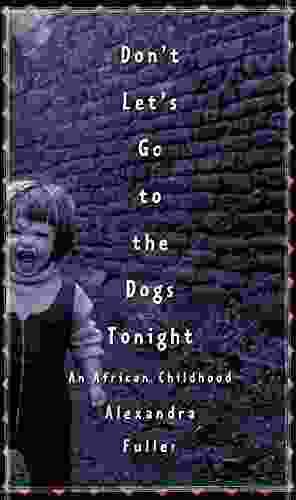
 Jan MitchellDon't Let the Dogs Tonight: An Alluring Tale of Love, Loss, and the Power of...
Jan MitchellDon't Let the Dogs Tonight: An Alluring Tale of Love, Loss, and the Power of...
 José SaramagoLan Sluder's Comprehensive Guide to Belize: An In-Depth Exploration of the...
José SaramagoLan Sluder's Comprehensive Guide to Belize: An In-Depth Exploration of the... Clark BellFollow ·19.3k
Clark BellFollow ·19.3k Asher BellFollow ·9.5k
Asher BellFollow ·9.5k Phil FosterFollow ·16.7k
Phil FosterFollow ·16.7k Guillermo BlairFollow ·18.4k
Guillermo BlairFollow ·18.4k Derrick HughesFollow ·18k
Derrick HughesFollow ·18k Allan JamesFollow ·18.2k
Allan JamesFollow ·18.2k Ezekiel CoxFollow ·16.6k
Ezekiel CoxFollow ·16.6k Jordan BlairFollow ·18.6k
Jordan BlairFollow ·18.6k
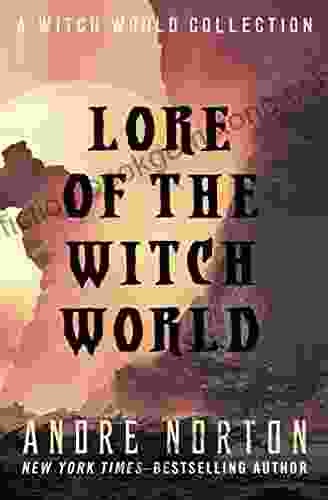
 Kyle Powell
Kyle PowellThe Enchanting Realms of Witch World: A Collector's Guide...
In the vast and...
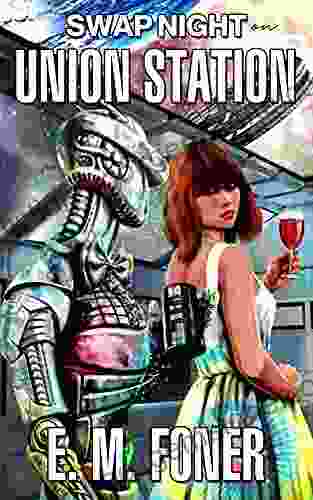
 Ethan Mitchell
Ethan MitchellSwap Night on Union Station EarthCent Ambassador 19: A...
On a crisp autumn evening in the...

 Gage Hayes
Gage HayesThe Last Reaper: A Military SciFi Epic That Will Leave...
The Last Reaper...

 Christopher Woods
Christopher WoodsUnveiling the Masterpiece: The Original Pattern Bible by...
In the realm of pattern design, there...
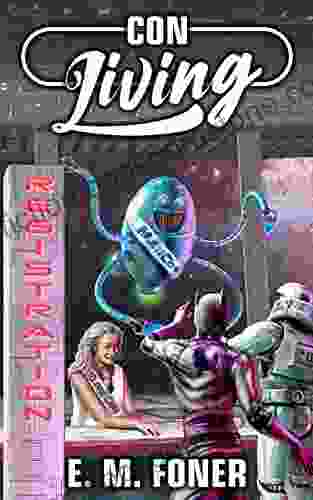
 William Golding
William GoldingDiscover the Unfathomable Con Living Earthcent Universe:...
An Expansive Cosmic Tapestry In the...
4.5 out of 5
| Language | : | English |
| File size | : | 69893 KB |
| Text-to-Speech | : | Enabled |
| Screen Reader | : | Supported |
| Enhanced typesetting | : | Enabled |
| Print length | : | 695 pages |


